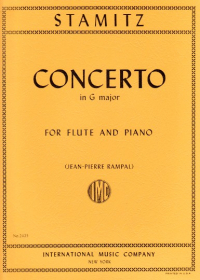Debussy, C :: Second Arabesque
-
ComposerDebussy, C
-
Instrumentation5 or More Flutes
-
PublisherMusicians Publications [FC112]
-
EditorDorsey, Kris (arr)
-
Orchestration4 fl, al fl, bs fl, opt stbs
-
Includes CD or Audio DownloadNo
-
ClassificationNot Applicable
-
GenreUndefined
Debussy, C
Musicians Publications presents Claude Debussy's Arabesque 2 arranged for flute choir plus by Kris Dorsey. Scored for 4 C flutes, alto flute, and bass flute, this arrangement also includes optional parts for bassoon or cello to add to the bass sound if desirable.
Claude Debussy was a French pianist and composer, who left a remarkable impact through his compositions. Bela Bartok described Debussy as the greatest composer of our time. Debussy s compositional style utilized aspects of many styles, including French Impressionism, Symbolism, jazz, oriental, and others. Impressionism was a new fad in the visual arts, which blended the colors to give the viewer an impression of the scene, in contrast to a direct, complete image. Debussy writes many of his works in a similar manner, blending the pieces together to make one unique sound. He would often hint of a concept or topic, but he never directly mimics the subject, such as in Voiles .
The title of the prelude Voiles' translates to sails or veils.' Debussy most likely used this word, which has a double meaning to allow the audience to consider their impression of the music. Debussy s title of the preludes are interesting because he did not place the title until the end of the piece because he desired the audience to create their story through their impression of his music. Upon imagining a unique story, listeners would discover Debussy s intentions for the piece.
Debussy expanded harmonic vocabulary and practice of the time by often utilizing ninth and thirteenth chords as well as parallel fifths and octaves. In 1889, Debussy attended the Paris Exposition. This exposition featured art and music from all over the world. Debussy heard the Javanese Gamelan, a type of orchestra from Indonesia, and his music was forever changed. He listened to the scales of this orchestra and began to write with pentatonic scales, whole tone scales, and modes. One may hear these scales throughout Voiles' and hints of the scales in Deux Arabesques . Although Deux Arabesques is one of his earlier works, one may hear his developing style as he experimented with the idea of the arabesque. Arabesques typically contain a rapidly changing series of harmonies that decorate, without furthering, a point in the progress of a composition. Debussy utilizes this musical technique through fluctuating chords and harmonies throughout the piece. Debussy began breaking typical functional harmony progressions by choosing what sounded good for the moment. Debussy s large dynamic range includes a wide range in the quiet level. To play Debussy s works, pianists must vary their touches on the keys to produce the wide variety of colors and tones for the pieces. All of his scores are detailed, and Debussy expected the performers to follow his notations exactly. Debussy s legacy continues today through his compositions.
- Haley Myers, 2014
-
ComposerDebussy, C
-
Instrumentation5 or More Flutes
-
PublisherMusicians Publications [FC112]
-
EditorDorsey, Kris (arr)
-
Orchestration4 fl, al fl, bs fl, opt stbs
-
Includes CD or Audio DownloadNo
-
ClassificationNot Applicable
-
GenreUndefined
All online purchases greater than $200 (before tax) are eligible for free shipping within the US. (Some Exceptions apply.) Online purchases over $200 being shipped to locations outside the United States do not qualify for free shipping.
Items returned from a purchase utilizing the free shipping offer that brings the original invoice under $200 will result in the original shipping charge being re-applied.
Once shipment has reached its destination according to the shipping carrier tracking information selected, Carolyn Nussbaum Music Company is no longer responsible for the package.
*Please note that some items may vary slightly from the pictures on our website as manufacturers make changes to their products.
We accept Visa, Mastercard, and Discover for online purchases up to $10,000.
You may also assemble your order online and pay offline using the "Offline Payment" payment method during the checkout process. In this case, once you submit your order, you will be contacted via phone or email for payment details before your order is processed. For offline orders we accept personal checks, bank checks, money orders, or travelers checks, with other legal tender acceptable only per arrangement.















![Tchaikovsky, PI :: Nussknacker-Suite [Nutcracker Suite]](http://www.flute4u.com/var/images/product/262.280/D009790006574667.jpg)





